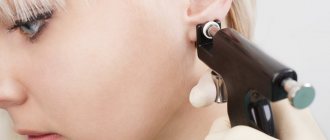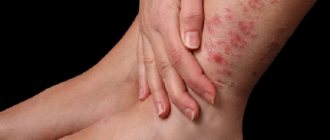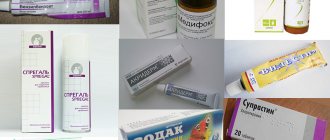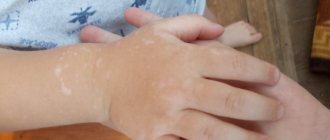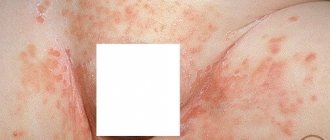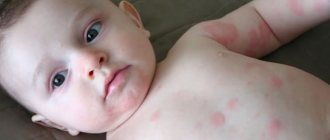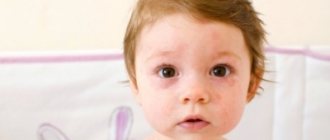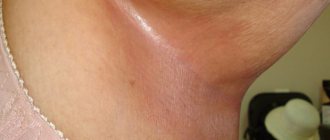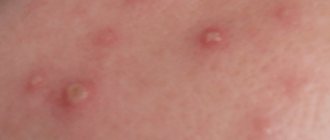Rash on the palms - a harmless symptom or a serious diagnosis?
Having discovered a rash on the palms of a child, caring parents usually immediately begin to sound the alarm. Rashes are often caused by diseases, often of an infectious nature, threatening the health and even the life of the baby. Sometimes they are quite harmless and go away on their own. In any case, the child’s body signals about violations occurring inside. It is the responsibility of parents and doctors to understand what a rash is and why it appears.
Types of rashes
The rash in children, located on the inside or outside of the palms and noticeable to the naked eye, differs in color, severity, structure and arrangement of elements:
- bubbles - small or large swellings of the skin, filled with clear liquid inside;
- pustules - similar to vesicles, but contain pus inside;
- papules - nodular elements in the thickness of the skin;
- spots - accumulations of small elements located on the same level with the general surface of the skin;
- blisters are dense, rough elements that rise above the general level of the skin;
- erosions, ulcers – violations of the integrity of the skin in depth, accompanied by discharge.
Important points before the doctor arrives
If any of the above types of rash are detected on the palms of the hands, parents should record other possible symptoms:
- increase in general body temperature;
- the appearance of clear nasal discharge;
- coughing;
- nausea;
- pain in the stomach or throat;
- urge to vomit;
- lethargy;
- reluctance to eat.
You should also note the possible presence of a rash on the child's feet, legs, or mouth. If nothing is observed, it is necessary to remember and write down what food the child previously ate, what objects he played with and held in his palms. It is important to promptly note the child’s contact with a sick person and the possibility of infection.
All additional symptoms and knowledge will help make a quick and correct diagnosis.
Causes of the rash
In most cases, the factors leading to rashes are:
- Infectious diseases - accompanied by signs characteristic of acute respiratory infections, occurring along with a rash or after a few days. The most common diseases with a rash on the palms of the palms:
- chickenpox (smallpox) – spots that appear at first quickly turn into blisters up to 5 mm in size, the rash usually itches; located on the palms, face, head, torso, in the mouth;
- rubella - many small spots localized mainly in the folds of the arms and legs, on the outer side of the palms, they are accompanied by signs of intoxication;
- measles - a rash appears after a rise in temperature and other signs of infection, starting from the head, then moving to the torso, palms, arms, legs; the spots are red, large, merging;
- scarlet fever - rashes in the form of small dots appear after the appearance of signs of sore throat on the second day; especially abundant in skin folds, folds, on the outside and between the fingers;
- Allergic reaction. Hives on the palms of a child appear after he has directly touched the allergen or ingested it. Substances that cause allergies: dairy products, sweets, medications, animal hair, dust, cream, powder, etc. The rash is bright red, raised, itchy; detected with a runny nose, sneezing and other manifestations of allergies.
- Diseases from insect bites, parasites. Classic examples would be bites from mosquitoes, bees, and wasps, to which the child is allergic. The most common parasite that causes a rash that itches and appears between the fingers, palms, and genitals is the mite. The disease is contagious and is called scabies. Multiple mosquito bites, flea bites, or jellyfish stings should be distinguished from a rash.
- Diseases of the circulatory system. The rash is quite characteristic, hemorrhagic, and occurs due to the destruction of small vessels and effusions into the skin. It looks like a bruise or small rash in the form of dots.
- Poor hygiene. As a result, it leads to the appearance of diaper rash, dermatitis, and prickly heat on the back of the hands. Constantly taking air baths, frequent bathing and timely changing of diapers will help to avoid problems.
If redness appears on the legs or palms, similar to a rash, the baby may have come into contact with nettles. Observe your children carefully while out and about at home, the overall picture will help the medical report.
blisters on the palms of a child
Games
for developing fine motor skills from 0 to 5 years old
Massage
Most often, massage is used in activities with infants, so, as a rule, it is done by the mother. Older kids can later do it on their own.
Finger massage exercises Place your baby's palm on your palm and stroke each finger. Using your thumb and forefinger, massage each baby's finger in a circular motion. Apply gentle pressure to your baby's fingertips. Make a fist and unclench your child's hand. Finish the massage with light patting movements on all the baby’s fingers.
We develop the strength of the baby's fingers.
To do this, we take any rubber pear, I drew eyes and a mouth on it as if it were a person, and we show the baby how it can be squeezed and unclenched; at the same time, you can invite the baby to blow away a feather or a table tennis ball, or something else, with the force of the air coming out of the pear. something light. We use the same bulb when bathing - we fill it with water and then throw it out. In addition to the pear, you can also use rubber squeak toys.
Games with beads Toys
: beads or beads of different colors, shapes and sizes, boxes, thick thread or soft wire Games with beads occupy a special place in the Montessori games system.
The development of a child’s fine motor skills greatly influences the development of the child’s thinking and speech acquisition. Beads or seed beads are offered to the child mixed in one box. The baby puts them in other boxes, guided by some principle he has chosen, for example, by color. It is recommended to take the beads with one or two fingers. It is important that there are not too many beads. Otherwise, there is a danger that the child will lose interest in the game without finishing what he started. It is also interesting and useful to string beads onto a thread, making beads. “Colored paths”
: beads are carefully sprinkled onto the table with three fingers (“pinch”).
It is advisable to determine the size of the path in advance so that the baby learns to distribute the material evenly. “Sprinkle the paths”
Invite the child to sprinkle “sand” (semolina, millet) on a path on the table 3-5 cm wide.
Limit it to something, such as strips of paper. Play: the path can go from one house made of matches to another. Sand should be sprinkled with three fingers (folded in a “pinch”), without going beyond the edges of the path. When playing in the yard, you can make a path between two sticks, sprinkle “sugar” on a shortbread “cake,” etc. “All the clothespins” Description - we practice pinning clothespins to the edges of a bowl.
Materials needed: colorful clothespins, bowl. What does this give? Trains concentration, motor skills, eye-hand coordination. Clothespins are a great exercise machine for little fingers.
Age - we have been playing this game since we were 1 year old.
If the baby is very small, we string clothespins around the perimeter of the box ourselves, and let him take them off. You can show older children how to “fasten” clothespins, and they will try on their own.
Show your child how they can be attached to any flat object, for example, cardboard, a wide ruler, or a plate. Over time, the task can be complicated: ask your child to fasten the clothespins to a stretched rope. To make your classes more fun, make special cardboard blanks, for example, you can cut out the silhouettes of a Christmas tree and the sun. It will be much more interesting for the child to attach needles from clothespins to the Christmas tree, and rays to the sun.
The next step is to practice, for example, pinning colorful sheets of paper to a stretched rope with clothespins. Helping mom hang up the laundry (feed clothes, hang clothes and attach with a clothespin).
"Beads in a vase"
: take beads from a flat plate and throw them with three fingers into a small vase.
It is desirable that the neck of the vase be narrower. “Let’s put it in order
”: pour beads of two colors into a bowl (about 5-7 beads of each color) and place two saucers to the right of the bowl.
Suggest: “Let’s put all the red beads in one saucer, and all the green ones in the other.” To spice up the game, say, for example, that this is a treat for the bear and the bunny, and the bear only likes cherries, and the bunny only likes gooseberries. You need to move the beads one at a time, taking them with three fingers (show). If some beads fall on the table, ask them to pick them up with a scoop. Be sure to finish the job - this skill is very important. Therefore, at first, take fewer beads. "Pool" for fingers.
To make it, you will need a 5-liter plastic mineral water bottle (any other container with transparent walls, except glass, will also work).
Cut off the top half of the bottle - you will need the bottom half. To ensure safety, cover the edges of the cut with tape or tape and fill the bowl with any cereal. Hide the cube in the resulting “pool”. Show your child another cube and ask him to find the same one in the “pool”. When the child becomes comfortable with the task, increase the number of “immersed” objects. These could be ping pong balls, jar lids or teaspoons. "Who's hiding?"
: pour beans, peas, buckwheat, rice into a bowl. Hide animal figures there and ask your child to find who is hiding in the cereal? :-) Useful for the development of fine motor skills.
Learning to lace.
The goal is to practice stringing beads of different sizes, colors and shapes?
Required materials: balls of various shapes, colors and sizes, thread. What does this give? Development of concentration, training of fine motor skills of fingers, eye-hand coordination, sorting skills.
Age: from 1 year.
Beads for grandma
You will need approximately 200g of large gap pasta and a long string. The task is clear: string the pasta onto a string. Of course, such jewelry is not suitable for going out, but it is quite suitable for a home party.
Stringing on a cord.
Any figures with a hole for stringing. From 1.5 years.
We learn to grasp objects with a clamp.
The goal is to practice taking cubes of different colors with a clamp and packing them into different cells.
Materials needed: clamp, multi-colored cube.
What does this give? Development of concentration, training of fine motor skills of fingers at an early age, eye-hand coordination, sorting skills.
Age – you can try playing this game from 2 years old.
«Open and close»
Description - show your child how to unscrew the lid from a jar and how to screw it on. Materials needed: several thick glass jars (I used coffee and salt jars). What does it do? Training eye-hand coordination, motor skills, attention coordination.
Age - we play this game from about 1 year and 7 months.
1. By the way, to make your child more interested in developing this skill, you can put a small toy in a jar and ask him to open it, and then transfer it to another jar and close it.
2. Come up with a game: for example, the baby can be a doctor who has a lot of jars of medicine, or a housewife who keeps different cereals in jars. Place several small jars with closed lids in front of the child (the jars should be different in size and shape). Offer to open all the jars and then close them again, choosing the right lids. If the lids screw on, make sure your child twists the lid and not the jar.
The game develops visual perception, visual memory, and fine motor skills.
Small screw-on bottles (game for children 2-3 years old)
Hide small toys or candy inside, and leave some bottles empty. Invite your child to guess in which bottles the toys are hidden. It will be very good if he himself thinks of shaking the bottle and listening to see if there is anything there. Once all items have been removed, ask your baby to close the bottles. The game develops auditory attention and fine motor skills.
Learning to screw nuts into bolts.
Description - we take multi-colored toy nuts and bolts of different shapes and sizes and train the skill of screwing and unscrewing. Required materials: toy nuts and bolts. What does this give? Motor skills training.
Age: from 2 years.
Game "More and Less"
Toys: bottles, bubbles, cereal cans with lids of different sizes. Unscrew the caps and caps from several bottles of different sizes, it is acceptable if some of them contain water. Show your child how the caps are picked up and screwed back on. Invite your baby to do the same procedures with his own bottles and bubbles. Watch his activity carefully.
We play with insert frames. (Introduction to forms).
Description - show your baby how to assemble and disassemble these inset frames, so the baby can get acquainted with different shapes. Materials needed: buy your baby frames with multi-colored geometric inset shapes. What does it give? Training of motor coordination, manual dexterity.
Age - from 1 year.
Playing with frame inserts
.Description - show the baby how to assemble and disassemble such puzzles, thus, the baby will get acquainted not only with various shapes, but also with wild and domestic animals, numbers, household and agriculture, fairy tales, etc. Required materials: buy give your baby frames with multi-colored insert shapes. What does this give?
Movement coordination training, manual dexterity , intensive development of fine motor skills.
Age - from 1 year.
We play with insert frames. (Introduction to shapes and parts).
Description - show your baby how to assemble and disassemble these inset frames, so the baby gets to know the different shapes and parts. Materials needed: buy your baby frames with multi-colored geometric inset shapes. What does it give? Training of motor coordination, manual dexterity.
Age - from 1 year and 5 months.
Learning to cut with scissors
.Description - show your baby how to cut paper using scissors. Materials needed: blunt-tipped scissors, multi-colored paper. What does this give? Motor skills training, eye-hand coordination
Age - you can try playing this game from about 2 years old.
Creation.
Learn to draw
.
Description - Give your child a variety of colorful pencils and markers and offer freedom of action. Materials needed: colored pencils, markers, crayons, paper. What does this give? Developing self-expression and creativity.
Age - we have been playing this game since about 8 months.
Note. By the way, don’t limit yourself to a standard piece of paper, develop the child’s unconventional thoughts, invite him to draw on whatman paper, A3 sheets and others. The child must get used to it from a very young age that the pictures he draws come in different sizes. You don’t want your baby to think in a standard way...
Drawing
: wax crayons, paints, felt-tip pens (it’s better to take water-based ones (“washable”) - they wash well). Children at this age usually find it difficult to draw with pencils - you need to make a strong effort to leave a mark on the paper, and they also break quickly.
Learn to use paints
- wash the brush after each color, moisten the brush in water.
Finger painting.
Sponge painting
(strips and stamps cut from a sponge for washing dishes; gouache or finger paints are used for painting with a sponge).
Drawing silhouettes:
A stencil is made from a sheet of paper - a simple silhouette is cut out inside the sheet - for example, a Christmas tree, a house, a mushroom. The stencil is placed on a blank sheet of paper, the child decorates the stencil window (silhouettes of a Christmas tree, mushrooms, etc.). At the end of the work, the stencil is removed and a cute children's creativity remains on the bottom sheet of paper.
Stamps.
In a playful way, start learning to draw lines (vertical, horizontal), closer to 2 years - circles. Important
- the skills of drawing lines and circles at this age are very individual, some learn this later, some earlier, it is necessary to take into account the interest and abilities of the baby.
Closer to two years
start mastering coloring
(also very individual - after all, most children successfully master this skill somewhere after two).
It is better to learn to paint with paints - this technique is much easier for a child. You can start learning by coloring silhouettes of fish, mushrooms, etc. cut out of paper. Cereal application.
Finger painting.
Learn to draw using painting sponges.
Description - pour the paints into small containers and invite your child to take a sponge, dip it in the paint, and then leave a mark on a piece of paper. At the same time, tell your baby the name of the shape and its color. For example, let's dip a bear in yellow paint? there will be a yellow bear. Materials needed: sponges (you can buy them or cut them yourself), paints, paper. What does this give? Training fingers, developing fine motor skills, and most importantly, with the help of such materials, the baby reveals the connection between an object and its color.
Age - from 1 year.
We step with our fingers.
We draw a path, a house, a cat on the sheet. The baby “walks” along the path and traces it with his finger.
Assembling/disassembling the pyramid.
Folding disposables
(or any unbreakable) cups one into the other.
Assembling and disassembling matryoshka dolls
(the older the child, the more nesting dolls).
Pushing coins
different sizes in a piggy bank.
Small rubber bands
- learn to put a pyramid stick on your fingers, or on small rubber toys.
Learn to squeak
squeaking toys.
Splash
splashers in the bathroom
Wrapping it up
a toy/something bright and attractive 4-5 candy wrappers. The child unwraps all the candy wrappers and folds them neatly.
And gras with paper
. The main thing is to explain every time that you can only play like this with old and unnecessary paper. This is very important, otherwise your baby will tear everything in his path. We tear the paper into small pieces.
These games can be played with younger children, even from 6 months.
Let's make origami!
After all, crumpling, folding or tearing paper is also the development of manual dexterity and fine motor skills. Origami also develops spatial imagination, teaches you to read drawings, and develops creative abilities.
«Paper balls and snails"
Playing with paper is also a very useful way of spending time, and besides, this activity will not require any special financial expenses from parents. Teach your child to crumple paper and roll paper balls from crumpled sheets. And a two-year-old child will be able to independently create a paper sculpture from them - a funny snowman! Another useful activity is pinching - opening small pieces from a whole sheet of paper with your fingers. It is quite possible that after such a “paper” game the apartment will require a thorough cleaning, but these are minor things compared to the pleasure your child will get from the process of tearing paper. And the benefits for the development of motor skills are considerable. Show your child how to roll paper strips. You get rolls or snails - whatever you like!
Cutting
from paper of any shape (for example, a Christmas tree) with the right and left hands.
Learn to make applications from 2-3 elements
(for example:
house
(3 elements) - roof, house, window;
tree
(two elements) - trunk and foliage).
Important:
first the child must become good at making appliqués from one element and appliqués from several objects.
Game “stick the figure in its place”:
Apply stickers.
Paper applique
(various textures), applique from torn paper, applique from “crumpled” paper.
"Slide for beads"
Beads, a groove (made from a hose, for example), a saucer. We make a slide groove and roll the beads along the groove into the saucer. You can have a child compete to see whose bead will roll faster, and if the child guesses that in order for the bead to roll faster, you need to increase the angle of inclination.
Threading
threads into a needle. From 3 years
Sewing
buttons and sewing materials with various types of seams. From 5 years (you can use sets for children with a plastic needle)
Winding
thread onto a spool and winding it into a ball.
Drawing the outlines of objects (for example, a table, a house) first from large, then from smaller sticks.
Making a chain of 5-10 paper clips
different color.
Sun
. The sun needs to be decorated with multi-colored paper clips, attaching them along the length of the entire circle. This exercise meets the needs of babies to catch and string.
Sand games
- learn to make Easter cakes, pies, pour, pour.
Games with a Lego-type constructor
(connecting parts, separating parts),
mosaics
.
Cubes
- build towers, build houses.
Build paths from cubes
, designer, books.
Hammering nails.
Wooden nails with a hammer. They can be hammered into plasticine or soft clay.
Sticking push pins
in a wooden block or polystyrene foam.
Erasing
objects drawn with an eraser.
Crumpling handkerchief
(take the handkerchief by the corner with one hand and place it in your palm, using the fingers of that hand only).
Touching rosaries or beads
simultaneously with both hands towards each other and back.
Compressing and unclenching the expander.
Games with cereals to develop hand motor skills
"Don't spill and don't spill":
First, pour some cereal into the jug and show your baby how, holding the jug with his right hand and holding it with his left, pour the cereal into a glass standing to the left of the jug. (The child should sweep any spilled grains into a dustpan with a brush.) Do not forget to discreetly praise the child if he cleaned up carefully. You should move on to transfusion only when the child has mastered oversleeping well.
Learning to pour pasta from one container to another
.Description - show your baby how to pour pasta from one container to another.
Necessary materials: 2 small bowls, pasta (in addition to pasta, you can use rice, buckwheat and other cereals, but it’s still better to start with larger materials).
What does this give? Training motor skills, concentration, eye-hand coordination.
Age - we play this game from about 1 year and 4 months.
"Magic Sieve"
: say: “Rice and semolina are mixed in this cup (show grains of rice and semolina separately). How to select all the rice grains from here? This is difficult to do even with your small and dexterous fingers. But a sieve will help you!” Separating one grain from another is like a magic trick for a child. Explain why this happens by first pouring clean semolina into the sieve, and then rice. The sifted rice should be poured into the prepared plate. Enjoy the results achieved with your child.
«Sprinkle with a spoon
»Place two cups on the tray: on the left is a cup with cereal, and on the right is empty. (Both cups should be dry.) First, moving the child's hand, show how to take a partial spoonful of cereal, wait until the cereal stops falling from the spoon, and, smoothly moving your hand, move the spoon to the right cup and tip it over it. Help your baby pick up cereal when there is little left (tell him to bend the cup with his left hand). It is useful to combine this exercise with stirring. For example, a child can pour sugar into tea and stir it.
Sprinkle the grain
The child needs to pour buckwheat, peas or rice from one bowl into another bowl through a funnel.
Sorting
beans, beans, peas, as well as cereals (millet, buckwheat, rice).
And the game
“ drawing on semolina ” .
You can take a dark-colored bowl or a shoebox lid, put a sheet of colored paper on the bottom, sprinkle semolina on top and draw. When the painting is completed, it is enough to shake our container and again we have a “untouched sheet” in front of us, which means we can begin to create a new masterpiece.
Portable sandbox.
To do this, you will need a tall container and 10 kg of millet, various toys for the sandbox - mills, buckets, scoops, sifters.
Feed the pig.
As a pig, you can use a liter plastic bottle, suitably decorated, or a box with a small hole. Instead of beans, you can use any breakfast cereal or peas. The main thing is that the child takes one thing at a time.
And games peas .
Oversleeping.
Pour the peas into a bowl and place the bowl on a tray.
Pour the peas onto a tray in handfuls, using different spoons: tea spoon, table spoon, wooden spoon, or even a ladle. And then we collect the peas back into the bowl. Pour the peas from the bowl into another bowl
.
Again, with different spoons or just handles. You can pour by simply tilting the bowls. It will be more interesting if the bowls are of different shapes and volumes. We “bury” small toys in the peas in a bowl
.
The baby pulls them out with his hand or a spoon. You can ask to find a certain toy. An older child can hide the figures himself and tell the adult what he hid. We sort the peas.
Pour some yellow and green peas onto a tray and place them in yellow and green cups, respectively.
You can mix peas with lentils or beans and separate them into cups. Drawing on peas.
Spread the peas in a thick layer on a tray or box lid and write or draw with your index fingers.
You can draw a bright picture on the box and dig it out of the peas. You don’t have to draw, but simply put bright little calendars or cards with letters and numbers on the bottom. We train the pinch grip.
We take a pea with our thumb and forefinger and drop it into a small test tube.
Finding a test tube at home is problematic, so we replace it with an empty felt-tip pen or a pen base. Of course, first check for yourself whether the pea climbs through easily or whether it requires effort. We sift.
If you mix peas with semolina, you can play sifting.
Pour our peas and semolina into one bowl, and place a sieve on another bowl. When pouring, the peas will remain in the sieve. And games with plasticine, clay and dough.
The fact is that using these plastic materials, the baby simultaneously engages in self-massage of his fingers, which is incredibly useful for the development of motor skills.
M mute
plasticine in the hands - combining self-massage of the fingers and hands and developing muscles. Let's poke it and make holes with one straightened index finger or all of them at once.
Pinching off.
The baby learns to pinch off a piece of plasticine and roll it into a mug or sausage.
Pressure.
Prepare small multi-colored plasticine balls for the baby in advance and offer to press them with your finger and stick them to the paper.
For older children, you can already learn to cut plasticine using a special plastic knife and sculpt a ring. Mothers can make some little person or animal themselves, stimulating the baby to creative activity.
Smudging.
You can also prepare a simple picture in advance, for example, draw a ball and invite your child to color it with plasticine.
Application on the test.
You can invite your child to press various objects into plasticine or dough, for example, beans, peas, seeds, beads.
You can also make holes in dough or plasticine, and then put small objects into them.
«We make koloboks, sausages and pancakes»
Give your baby a small, crushed piece of plasticine. Offer to prepare a holiday dinner for the dolls. Show how to make “koloboki” (rolling balls), “sausages” and “pancakes”. Then from these “blanks” you can “assemble” figures of people and animals. When helping your child, do not fetter his imagination - defeat the temptation to sculpt instead of him.
games with buttons for children
Stringing.
Sorting by size
.
Mix several different sets of buttons and invite your child to sort them (for children 3 years old). The game develops attention and perception. Place buttons in piles
(towers).
Compete with the child whose pile will be higher (for children 3-4 years old). The game develops hand-eye coordination and hand motor skills. Sorting by color.
Place a variety of buttons on the table.
Ask your child to choose all the red ones; all small; all buttons with two holes, etc. (for children 4-5 years old). The game develops attention. Pattern.
Arrange the buttons in a row in a pattern, such as red-white-redwhite.
Invite the child to continue (for children 5-6 years old). The game develops attention and thinking. Laying out figures from buttons
.
Laying out buttons according to the template
to certain places.
Fighting rashes
Treatment options must be prescribed by a doctor after a thorough examination and accurate identification of the causes of the rash:
- if the disease is caused by a virus, specific treatment, as a rule, is not required;
- for infections caused by bacteria, a course of antibiotics is required;
- allergic rashes require avoidance of further contact with the allergen and the use of antihistamines;
- vascular diseases are more accurately diagnosed by a hematologist;
- Scabies will require a trip to the dermatologist.
The use of creams, ointments, balms prescribed by the doctor will relieve itching accompanied by rashes.
Do not neglect childhood vaccinations, maintain hygiene, try not to overload your child with sweets and respond in a timely manner to any rashes on the palms, feet, and legs - these are the best preventative measures against rashes.
Allergic reactions
Allergic rashes on the feet of a child are caused by various factors. Depending on the type of irritant and the method of contact with it, they appear only in certain areas or throughout the body.
What causes allergies on the feet?
A tendency to allergic reactions can trigger eczema. This is a chronic disease with a hereditary predisposition. Very often it occurs in childhood. There are several types of eczema. One of them is dyshidrotic. Appears on the palms, soles, sides of the feet, and toes. The elements of the rash look like clusters of fluid-filled blisters up to 5 mm in size, accompanied by itching. After the bubbles open, erosions and crusts form.
If an allergy is detected, you need to be careful with irritants and, if possible, avoid contact with them. As first aid, give your child an age-appropriate antihistamine. Then be sure to contact your doctor to find out what to do next.
Types of rash
In a child, a rash on the feet and palms is classified according to the secretion contained in the blisters or its absence:
- Spots - formed on the skin in single or mass quantities. Color – pale pink.
- Papules - nodular formations appear in the middle layers of the epidermis.
- Pustules - a purulent process in the dermis leads to the formation of large blisters.
- Blisters - the rash contains a clear and liquid secretion.
- Blisters are noticeable round subcutaneous blisters with a rough surface.
- Erosion - damage appears on the surface of the epithelium, leading to the release of ichor.
Causes of rashes
A rash on the palms of a child is a natural reaction of the body to the consequences of insufficient hygiene. But the causes of skin spots can be much more serious.
Infectious diseases
The incubation period of many infectious diseases is quite long. After contact with a sick person, there is time to prepare and carefully monitor the condition of the skin.
Infectious diseases that provoke changes in the structure of the epidermis:
- Chickenpox - itchy blisters with clear liquid are localized on the head, gradually covering all parts of the body, including the feet and palms. In mild cases, body temperature rises slightly. In severe cases of the disease, chills, nausea, and enlarged lymph nodes appear.
- Rubella - a red rash on the palms of a child occurs after the rash on the face. It can cover the entire body. During rubella, the baby may complain of pain in the joints and muscles, and he will develop photophobia.
- Measles - large red spots cover the entire body, over time, single copies merge into one. Before the appearance of rashes in the form of red dots, symptoms of a common ARVI are observed, later conjunctivitis develops.
- Scarlet fever - a small rash covers the neck and face, descending further down the body. Before its appearance, streptococcal sore throat develops. The baby feels weak and nauseous.
- Meningitis - the toxin of meningococcus paralyzes blood vessels, this leads to the formation of local hemorrhages on the skin. The baby develops a rash, body temperature rises, and a severe headache.
All of these diseases require medical supervision and placement of the small patient in the infectious diseases department of the hospital.
Allergic reaction
If infectious diseases are excluded, but formations in the form of bubbles remain on the palms and soles, then there is a possibility of developing an allergic reaction.
The skin reacts to:
- contact with household chemicals - powder and conditioner for washing clothes and children's clothes;
- food products - milk, citrus fruits, eggs, berries, honey and others;
- tap water – high chlorine content;
- animal hair and saliva - dogs, cats;
- house dust – it contains waste products of bed mites.
Young children cannot talk about what worries them. But spots on the palms and soles of the feet cause itching during an allergic reaction.
That's why kids constantly scratch their hands and heels on any surface, and sometimes try to bite their palms. This behavior should alert parents.
Parasitic infestation
There are times when parents are confused and do not understand the reasons for the appearance of spots in their child. They ask the pediatrician what it could be and how to eliminate skin problems. And it turns out that the rashes are the result of helminths multiplying in the body.
They are parasitic microorganisms that produce toxins that the immune system tries to fight. As a result of the production of protective cells of the epidermis, an allergic rash appears, which itches and inflames nearby tissues.
The presence of parasites is manifested by symptoms:
Sensitive children's skin is a favorable environment for the activity of fungal bacteria. Their active reproduction on the skin leads to skin rashes - pimples on the feet and palms turn into erosion and peel off.
Prevention
Preventive measures reduce the risk of developing urticaria several times. Their implementation is mandatory if regular allergic reactions occur on the back and other parts of the child’s body.
To avoid the negative consequences of urticaria in children and its development in general, it is strongly recommended:
- ventilate the room 2-3 times and do wet cleaning daily;
- monitor the humidity in the room and prevent dry air (normally, the humidity should be at least 50–60%), you can use special humidifiers;
- remove carpets, rugs, rugs, soft toys, pillows and other items that accumulate dust from the premises;
- refuse pillows and blankets with natural down;
- minimize or completely abandon household chemicals, do not wash the child’s clothes with washing powder and rinse aid, do not use glass cleaners, polishes and other products that are sprayed into the air;
- follow a diet and introduce new foods into the diet with caution;
- Do not plant flowering plants at home.
The child's body is characterized by increased sensitivity to external stimuli. Therefore, urticaria in infants and older children is very common. Whether this disease will become the cause of the development of pathologies in older age depends only on the parents and their actions to instill in their child the correct food and hygiene habits.
Author: Dana Shaimerdenova, doctor, especially for Dermatologiya.pro
Help a child
To confirm the diagnosis, the pediatrician will prescribe blood and urine tests, scrapings for microflora and tests for allergens. Depending on the result, effective therapy is prescribed, aimed at relieving symptoms and combating a specific disease. But before a diagnosis is made, parents should help the child get rid of discomfort.
To do this, you should take measures:
- If the problem is not accompanied by any additional symptoms, then the inflamed areas can be lubricated with a children's itching reliever - Advantan, Lokoid.
- For newborns, you can pour a decoction of string or chamomile into the bath.
- If the child is allergic, they are given an antihistamine for 5 days - Suprastin, Tavegil, Erius. Its dosage depends on the age and weight of the baby.
- Eliminate contact with the allergic substance. If this is a food product, then it is prohibited to give it to a child. If possible, exclude animals from the house and carry out general cleaning to get rid of dust.
- Rashes caused by a bacterial infection are treated with antibiotic medications.
If the baby’s feet and palms become covered in spots, and his body temperature rises to critical levels, then parents should urgently call for medical help.
How to recognize the disease
Each disease is characterized by its own type of rash - in the form of blisters with or without liquid inside, spots, small pimples, red dots, blisters. Their location is also different - points and pimples can be localized both in specific places - on the arms, legs, face, and affect large areas of the body.
| Disease: | Characteristic symptoms: | Redness of the skin, itching, very small blisters, single or in groups. They can be found on the back, neck, in the folds of skin on the arms and legs, in the armpits, and groin. No temperature. | The most common manifestation of skin allergies is urticaria, so named for the similarity of the blisters to nettle burns. Other manifestations are also possible, for example, a red rash on the arms and legs, similar to common heat rash. With allergies, the skin itches and without proper treatment, the spots spread to other parts of the body. In most cases, the reaction occurs without temperature. | |
| Chickenpox Manifests itself as blisters that burst and form crusts. Their number increases in the first 2 days, then decreases. The temperature may rise to 37 and above. | It begins with the appearance of red spots on the face, which then spread to the body. Redness lasts from 1 to 7 days. The temperature can rise to 38°C. | It unites all types of lichen with small, itchy nodules that merge into “islands” of irregular shape. Most often, spots form on the arms and legs, but can affect the neck and torso. The temperature does not rise. | Manifestations of a pustular nature, they are caused by staphylococci and streptococci. The disease begins with the appearance of red tubercles, which turn into pustules. They quickly burst and crusts form in their place. The skin almost does not itch, pustules appear on exposed parts of the body - face, hands, feet. | Symptoms are a small blistering rash on the legs and arms, hands, and feet. There is itching, which intensifies at night. On the surface of the skin, passages through which parasites move are visible. The passages look like thin short threads and can end in a bubble, under which a white dot is visible - in fact, the tick itself. |
| Nervous rash | Red itchy spots are located on any part of the body. The patient has irritability, anxiety, tremors in the limbs, and possibly an increase in body temperature. Based on the appearance of the bubbles and accompanying symptoms, the doctor can make a preliminary diagnosis right at the patient’s home. For parents of a child who has developed a rash, photos with explanations will help them navigate. |
Preventive measures
Having looked at the photos with explanations on the Internet pages showing the types of skin rashes, the mother should do everything to prevent her child from having such skin problems.
For this, preventive measures are necessary:
- timely vaccination;
- children's clothing - natural and high quality;
- If you are prone to allergies, do not have pets;
- regular wet cleaning of the house;
- long walks in the fresh air;
- strengthening the immune system;
- taking vitamin complexes;
- compliance with hygiene rules.
Features and causes of the rash
A rash in a child always causes concern for parents, but a specialist can correctly diagnose and recognize it. Therefore, if you notice a rash on your child’s feet and palms, consult a doctor who will conduct an examination and determine the causes of this phenomenon.
The most common causes of a rash in a baby include the following:
- allergic reaction;
- infectious dermatological diseases;
- the presence of parasites in the child’s body.
Rashes can also be associated with ordinary poor hygiene.
However, such a phenomenon may be evidence of the presence of diseases such as chickenpox, measles or scabies. You should pay attention to the fact that with such diseases, the rash begins to spread throughout the body over time. Scabies is also characterized by the formation of subcutaneous passages, which are formed by the scabies mite. When measles occurs, the baby not only develops a rash, but also a high body temperature. Chickenpox is different in that the rash can quickly spread throughout the body, and blisters also appear on the skin. During rubella, rashes can be localized not only on the palms, but also on the child’s stomach and thighs.
Rashes may also indicate the presence of a fungal disease or vascular problems.
A rash on a baby's feet often indicates improper or insufficient hygiene. Another cause of rash on the feet and palms is an infectious disease such as the Coxsackie virus. Children aged 1 to 7 years often suffer from this disease. You can become infected with this virus in any public place. In addition to the appearance of pimples on the palms and soles, the baby experiences a high fever and painful sensations in the mouth. This viral disease can be recognized not only by the rash on the feet and palms, but also by the pimples around the mouth.
Symptoms
It is important for every parent to know exactly how urticaria looks and manifests itself in young children. Allergic urticaria can occur at any age, but is usually diagnosed in children under 12–15 years of age.
The main manifestations of urticaria:
- Blisters . They appear on the skin of the face and body and look like small, red-pink rashes, similar to insect bites or irritation from nettles. Blisters appear first on the face and neck, but can appear anywhere - on the scalp, on the palms and soles, and on mucous membranes.
- Rash . The characteristic symptom of urticaria, which appears quickly, can coalesce and form large spots.
- Itching . Appears immediately with blisters and can be quite severe. Not a single form of the disease is complete without itching.
- Edema . An acute, pronounced reaction is characterized by swelling of the mucous membranes and mild swelling of the subcutaneous fat.
Diagnosis of pathology
Rashes can appear for various reasons , so it is very important to conduct a comprehensive diagnosis to determine all the possible factors that contributed to the development of such a pathology.
Never self-diagnose or self-medicate a child; only a qualified specialist can make a correct diagnosis and prescribe correct and effective treatment. The first step is to take the baby to an appointment with a pediatrician, who will conduct an initial examination and refer him to other specialists with a narrower profile. Often, an examination by a dermatologist is required, who may prescribe the following studies and tests to make a correct diagnosis:
- allergen tests;
- blood and urine tests;
- scraping for microflora.
The diagnosis is made based on the results obtained. Therapy may include both taking medications and using alternative medicine.
Carrying out therapy
Rash and red spots on the palms of a child should be treated comprehensively.
Therapy involves the use of both medications and external ointments, the action of which is aimed at relieving itching and other unpleasant sensations. Treatment is selected purely individually, depending on the causes of this pathology and the characteristics of the baby’s body.
If the cause of the disease is bacterial, then antibiotics must be included in the therapeutic course. Antiviral medications are prescribed to treat spots and red spots on the heels and palms of the hands that are caused by a virus. For mycotic lesions, a child, like an adult, is prescribed antifungal drugs.
Therapy also depends on the extent of the lesion and the severity of the disease. So, the doctor may prescribe the use of ointments for external use in combination with drug therapy. If the cause of the rash is an allergic reaction, then the allergen should be eliminated first. In this case, you should start taking antihistamines.
To treat scabies, sulfur ointment is used, which is applied exclusively to the affected areas of the skin.
To alleviate the child’s condition during illness, special attention should be paid to hygiene procedures; it is recommended to wear clothes exclusively from natural materials, since synthetics can only aggravate the situation. To speed up recovery, you can take baths with decoctions of medicinal herbs or baking soda.
Treatment
Each doctor will treat urticaria in children differently. The famous pediatrician Komarovsky does not recommend treating urticaria in children unless there is severe itching and swelling. Other doctors recommend complex therapy, which includes diet, medication and skin care.
Medication
- Antihistamines . The main method of treating urticaria. In the acute phase, these drugs are administered intramuscularly or by inhalation, and if the symptoms of urticaria do not bother the child much, the drugs are prescribed in tablet form. First- and second-generation medications include Suprastin, Tavegil, Fenkarol, Loratadine, Diphenhydramine. They have a sedative and hypnotic effect, but should not be taken for more than 7-10 days. Of the new generation drugs, children are prescribed Zyrtec, Claritin, Telfast, Athorax. They are almost free of side effects.
- Hormonal agents . For severe forms of allergies or developing edema, corticosteroids (Prednisolone or Dexamethasone intramuscularly) are prescribed.
- Enterosorbents . They help reduce the absorption of toxins from the intestines and accelerate their removal from the body. For children use Enterosgel, Polysorb, Smecta.
Folk
You can alleviate the child’s condition with rubdowns, baths or compresses:
- Baths with chamomile, string, calendula . Five st. l. raw materials are poured with 1 liter of boiling water, infused and poured into 10 liters of warm water.
- Baths with oatmeal . Five st. l. oatmeal is stirred in 1 liter of cool water and added to a bath of warm water.
- Compresses or rubdowns with herbs . One tbsp. l. chamomile or calendula is poured into 1 glass of boiling water, left for 1-2 hours and used to wipe the skin or prepare compresses.
It is important to remember that the use of traditional medicine recipes can lead to a worsening of the allergic reaction, so a preliminary consultation with a doctor is required.
Diet
Avoidance of food allergens is the most important condition for treatment. If urticaria occurs in a baby, you should stop introducing new complementary foods. When breastfeeding, the mother should follow a diet or use a hypoallergenic formula.
Basic principles of the diet:
- eliminate all possible allergens from the diet;
- follow a strict diet for 1–3 days with a minimum amount of food in the diet, and for the next 10–14 days the diet is expanded by introducing 1–2 foods per day;
- eat porridge with water (buckwheat, oatmeal, rice), fermented milk products without additives, boiled or stewed vegetables (potatoes, zucchini, carrots), yeast-free bread or crackers, lean soups with lean meat.
Skin care
If the skin of a child with hives is not taken care of, the blisters begin to become wet, the skin cracks, and secondary tissue infection may occur.
It is especially important to care for the epidermis if urticaria is diagnosed in newborns and children in the first year of life:
- Keep your skin clean . It is recommended to dry the skin with air baths. In infants, it is necessary to prevent diaper rash, especially if the blisters appear in natural folds.
- Reduce itching . Children are allowed to use creams and ointments such as Advantan, Fenistil, Elokom.
